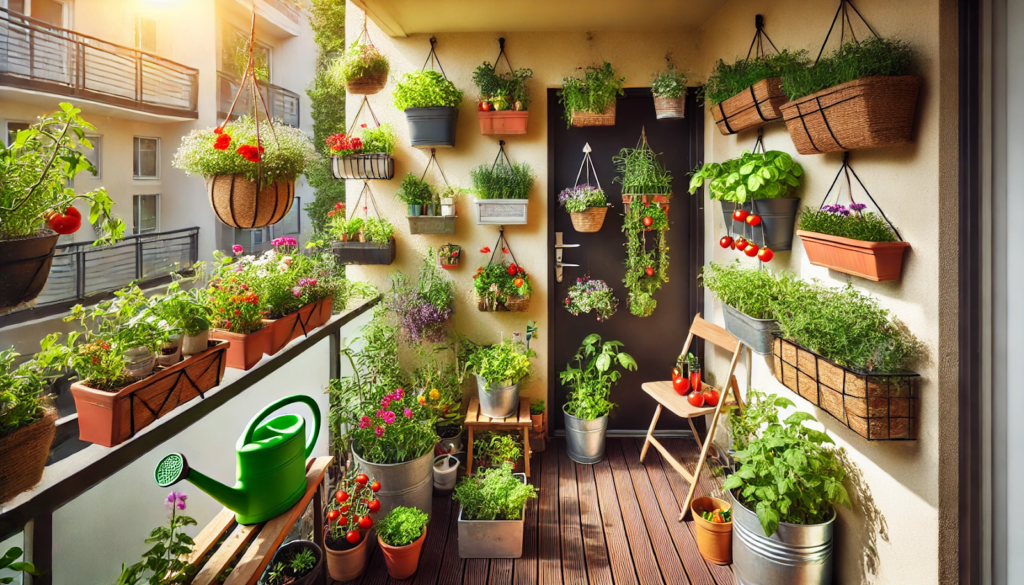Living in an apartment or urban area doesn’t mean you have to miss out on gardening. With a little creativity and the right setup, your balcony can become a lush, productive space filled with vegetables, herbs, flowers, or even small fruiting plants.
In this guide, you’ll learn how to maximize your balcony space to create a thriving garden, regardless of its size.
Why Balcony Gardening Works
- Accessibility: Step outside and harvest fresh herbs or veggies.
- Flexibility: Move containers around to optimize light or decor.
- Privacy & Aesthetics: Plants act as natural screens while beautifying the area.
- Well-being: Tending a balcony garden promotes relaxation and satisfaction.
Step 1: Evaluate Your Balcony Conditions
Before planting, consider the environment:
Key Factors:
- Sunlight: Observe how many hours of direct sunlight your balcony receives. Most vegetables and flowers need 6+ hours.
- Wind: Higher floors may experience stronger winds. Use windbreaks like lattice panels or taller plants.
- Weight Capacity: Don’t overload the balcony with heavy containers. Opt for lightweight pots and soil.
Step 2: Choose the Right Containers
Containers come in all shapes and sizes. Use a variety to make the most of your space.
Ideal Container Types:
- Railing Planters: Perfect for herbs and cascading plants.
- Vertical Planters: Maximize vertical space for flowers or greens.
- Hanging Baskets: Great for trailing plants like strawberries or petunias.
- Self-Watering Pots: Help maintain consistent moisture, especially in hot climates.
Step 3: Select Suitable Plants
Pick plants based on your available light, climate, and space.
Best Edible Plants:
- Tomatoes (Cherry or Patio varieties)
- Lettuce and Spinach
- Basil, Mint, and Thyme
- Peppers (Hot or Sweet)
- Radishes and Scallions
Best Ornamental Plants:
- Petunias and Marigolds for color
- Lavender for fragrance and bees
- Fern or Ivy for shade areas
- Succulents for sunny spots with low maintenance
Step 4: Soil and Drainage
Use high-quality, lightweight potting mix enriched with compost. Avoid garden soil—it’s too dense for containers.
Drainage Tips:
- Ensure all containers have holes at the bottom.
- Use trays or saucers to protect balcony flooring.
- Add a layer of pebbles to improve drainage if needed.
Step 5: Watering and Feeding
Balcony containers dry out faster due to exposure.
Watering Tips:
- Water early in the morning or evening.
- Use a watering can with a long spout for hard-to-reach containers.
- Mulch the soil surface to retain moisture.
Feeding:
- Use liquid fertilizer every 2–4 weeks during the growing season.
- Add compost tea or slow-release organic pellets to maintain nutrition.
Step 6: Vertical Gardening Ideas
Vertical setups increase your growing area and add a decorative element.
Vertical Garden Structures:
- Wall-mounted planters or shelves
- Hanging pocket planters
- Wooden pallets turned into vertical beds
- Ladder-style plant stands
Step 7: Creating a Garden Atmosphere
Your balcony garden should be both functional and inviting.
Design Tips:
- Mix textures and heights for visual appeal.
- Add solar lights or string lights for ambiance.
- Include a small table or chair for relaxation.
Step 8: Dealing with Common Challenges
| Challenge | Solution |
| Limited sunlight | Choose shade-tolerant plants like leafy greens |
| Wind exposure | Use heavier pots, windbreaks, or group plants together |
| Pests | Check plants weekly, use neem oil or soap spray |
| Overcrowding | Use hanging and vertical systems to expand upward |
Small Space, Big Potential
Balcony gardening proves that you don’t need a big yard to grow fresh food or enjoy vibrant blooms. With careful planning and consistent care, your small outdoor space can become a green retreat and a productive garden. Whether you’re growing herbs for cooking or flowers for beauty, your balcony garden will be a source of pride and joy.






